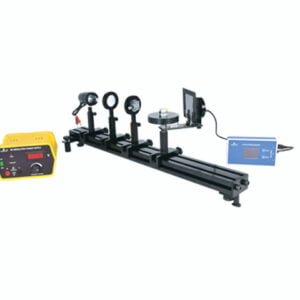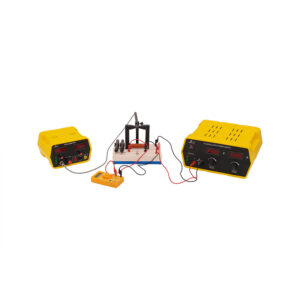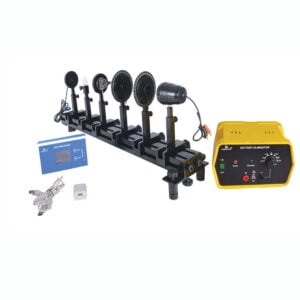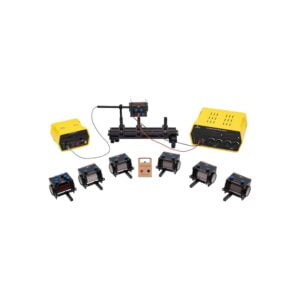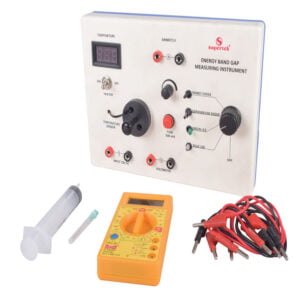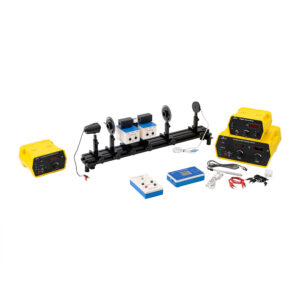Physics
-
Accessories
Laser Distance Meter
Portable Laser Distance Meter measures any distance from 0.05 to 40 meters, easily, quickly, and with high accuracy. Laser Distance Meter has multi-functions, including a self-calibration function, with an adjustable range of -9 to 9mm, and saves the latest 30 data values. Power is supplied by two AAA batteries (Included).
Specifications:
- Designed for Linear, Area, and Volume Measurement.
- Range 0.05 to 40m.
- Tolerance ±2mm.
- Readability 30 Degrees.
AC010 -
Accessories
Spectrum Tubes
Spectrum tubes produce bright, well-defined spectral lines when the gas inside the tube is excited before the spectroscope. The glass body is provided with metal end caps and has capillary along the middle portion to concentrate the discharge glow. For use with spectrum tube power supply (UP040).
Specifications:
- Length 200mm.
- Capillary Length 45mm.
- Max. Current 3mA.
AC021 -
Experiments
Atomic Spectra Experiment
OBJECTIVES
- To understand the concept of diffraction of light.
- To measure and analyze the emission spectral lines of different elements.
PRINCIPLE
The source of electromagnetic radiation is atoms. When the atoms of an element are in an excited state, they return to a lower energy state by emitting electromagnetic (EM) radiation. The transition of the electrons in the atom from a higher energy level to lower unique energy levels for the occupation of electrons, due to this the EM spectrum emitted is a unique signature of an element or a substance. The study of the characteristics of EM radiation emitted by atoms is called Atomic Emission Spectroscopy.
KEY FEATURES
- Precise Optical Alignment: The optical alignment of the components is attained by the optical bench, the set-up time is faster and experimentation is easy.
- Rotating table with On-board Telescope: The telescope on the rotating table is mounted with bearings for smooth rotation. The diffraction grating mounted is mounted at the center of the rotating table. The telescope is easy to focus on and operate. The angle of the rotating arm has a least count of 0.1° for accurate measurement of the spectral lines.
- Power Supply Built in the Discharge Tube Holder: The built-in power supply makes a more compact system with easier changing of the discharge tubes. Easy power connection and no unnecessary wire intrusions
WHAT YOU NEED
- OB1 Optical Bench Set 0.8m 1
- HA010 Converging Lens Holder 1
- HA012 Adjustable Collimating Slit Holder 1
- UP040 Spectrum Tube Power Supply Assembly 1
- UP035 Telescope Assembly 1
- AC018 Diffraction Grating 1
- AC021 Spectrum Tube, Hydrogen 1
- AC022 Spectrum Tube, Helium 1
- AC023 Spectrum Tube, Mercury 1
- AC024 Spectrum Tube, Krypton 1
- AC025 Spectrum Tube, Argon 1
Complete Equipment Set with Instruction Manual from catalogue.
ASE1-C -
Experiments
Brewster Angle Experiment
OBJECTIVES
Measurement of Brewster’s angle for a given dielectric dispersive medium.
PRINCIPLE
When un-polarized light is incident on the surface of a dielectric (such as a glass), at a certain angle of incidence the reflected light is completely plane-polarized. This phenomenon was discovered by Sir David Brewster and, thus, the specific angle is called Brewster’s angle or polarization angle. Also, from the experiment, it can be confirmed that the reflected ray and the refracted ray are 90° apart when the incident angle is set at Brewster’s angle.
KEY FEATURES
- Rotating Table: A simple, smooth, and compact rotating table. The rotating table used is extremely smooth to operate. It is a single assembly that holds a glass sample, analyzer, and light sensor, thus minimizing the size of the whole equipment. Smooth rotation makes measurement continuous and accurate.
- Light Sensor: This enables the measurement of light intensity at various angles of reflection. The meter reads with a precision of 1 lux. The Lux meter helps obtain a continuous smooth curve of angle vs intensity and determines the Brewster angle much more accurately than the manual method.
WHAT YOU NEED
- OB1 Optical Bench Set 0.8m 1
- HA001 Light Source Holder 1
- HA010 Converging Lense Holder
- HA012 Adjustable Collimating Slit Holder 1
- UP030 Rotating Table Assembly 1
- AC002 Analyzer Square 1
- HA511 Light Sensor Holder 1
- PH61022D/2 Power Supply for Light Source 1
- AC004 Glass Block 1
- DP1 Data Processor 1
Complete Equipment Set with Instruction Manual from catalogue.
BAE1-C -
Experiments
BH Curve Experiment
Objectives
To observe and study the magnetization behaviour of the ferromagnetic magnetic materials provided.
Principle
The B-H curve is the curve characteristic of the magnetic properties of a material or element or alloy. It tells you how the material responds to an external magnetic field, and is a critical piece of information when designing magnetic circuits. A Ferromagnetic material, retains its magnetization even after the external magnetic field is removed. And the reversal or change in the direction of the applied external magnetic field results in a change in the magnetization of the ferromagnetic material. It is seen that the change in the magnetization lags behind the change in the applied external magnetic field. Thereby, a hysteresis behaviour is exhibited.
Key Features
- Compact Setup – The apparatus design is compact and yet effective to perform the experiments with ease. The simple connections and stand to hold the teslameter probe, makes it easy to handle.
- Multiple samples included – Multiple ferromagnetic samples are provided to study the BH curves of the different materials. The removable cores make it easy to change between samples.
Equipments Needed for the Experiment
- PH94014 B- H Curve Measuring Apparatus 1
- PH64505 Multimeter 1
- PH61035D/5 Advanced Power Supply 1
- PH93240 Teslameter 1
BHC1-C -
Experiments
Beer Lambert’s Law Experiment
Objectives
To find the concentration of a liquid using the samples of known concentration using Beer Lambert’s Law.
Principle
Beer Lambert’s law relates the attenuation of light through a substance and the properties of that substance. Light interacts with matter in the following ways: emission, absorption, transmission, and reflection or scattering. Depending on the physical and chemical properties of the matter under interaction, there can be one or more ways in which light interacts. It is because of these interactions light can be used as a probe to measure the physical and chemical properties of materials.
Key Features
- Precise Optical Alignment: The optical alignment of the components is attained by the optical bench, the setting up time is faster and experimentation is easy.
- Digital Lux Meter: This enables the measurement of light intensity at various angles of reflection. The meter reads with a precision of 1 lux.
What You Need
OB1 Optical Bench Set 0.8m 1 UP001 Upright 2 HA001 Light Source Holder 1 HA004 Polarizer Holder 1 HA006 Analyzer Holder 1 HA012 Adjustable Collimating Slit Holder 1 HA025 Cuvette Holder 1 HA510 Light Sensor Holder 1 DP1 Data Processor 1 PH61022D/2 Power Supply for Light Source 1 AC006 Glass Cuvette 1 Complete Equipment Set with Instruction Manual from catalogue.
BLL1-C -
Experiments
Biot-Savart’s Law Experiment
OBJECTIVES
- Measuring the magnetic field of a straight conductor and of circular conductor loops as a function of the current.
- Measuring the magnetic field of a straight conductor as a function of the distance from the axis of the conductor.
- Measuring the magnetic field of circular conductor loops as a function of the loop radius and the distance from the loop.
PRINCIPLE
Electric currents generate magnetic fields. Biot–Savart law is an equation describing the magnetic field generated by a constant electric current. It relates the magnetic field to the magnitude, direction, length, and proximity of the electric current. In this experiment, we study the magnetic field characteristics in the straight conductors and different types of circular coils.KEY FEATURES
- Multiple coil variants: The equipment comprises a variety of coils to carry out experiments. One can study Biot Savant law for a straight conductor, coils of variable length, density, and a number of turns. All coils are mounted on a common horizontal bench and upright system.
- 2-axis Teslameter: The equipment is provided with a teslameter with probes to measure both axial and tangential directions. A square shaft mount is provided for the accurate mounting of the probes.
WHAT YOU NEED
- OB2 Optical Bench Set 0.4m 1
- HA015 Solenoid with Variable Turns 1
- HA016 Solenoid with Variable Lengths 1
- HA017 Solenoid with Different Winding Density (Set) 1
- HA018 Straight Conductor Holder 1
- PH93240 Teslameter, With Axial and Tangential Hall Probe 1
- PH61035D/5 Power Supply 1
Complete Equipment Set with Instruction Manual from catalogue.
BSL1-C -
Accessories
Data Processor
A compact data display system with the ability to capture, process and display multiple sensor data.
SPECIFICATIONS:
- 3.5” Touch display interface to be able to select which sensor data to be displayed.
- 3 sensor data can be interfaced at a given point.
- The Compact Size of 175mm x 100mm x 40mm makes it handy to use.
- Powered by a Micro USB connector makes it is more versatile.
DP1 -
Experiments
Energy Band Gap Experiment
OBJECTIVES
To find the energy band gaps for different semiconductor diodes and LEDs
PRINCIPLE
At an absolute zero-degree temperature, semiconductors are pure insulators. As the temperature is increased thermal energy creates vibrations in the crystal lattice and a few electrons, which acquire sufficient vibrational energy break their covalent bond, become free, and move to the conduction band. The energy required to rapture the covalent bond is designated as energy gap EG and termed as energy gap or band gap energy.
KEY FEATURES
- Built-In Heater: The heating element is built into the system and is powered by 12V input. The efficient heating mechanism heats the system to the required temperature in a few minutes with a minimum power requirement of 40W.
- Modular Design: The modular design of the setup allows the testing of multiple diodes as well as different LEDs.
- Built-In Voltage and Temperature Probe: All the necessary parameters to be measured are available directly on the setup itself.
WHAT YOU NEED
PH94002 Energy Band Gap Apparatus 1 PH61035D/5 Power Supply 1 PH64505 Multimeter 1 AC026 Syringe, 20ml 1 AC028 Silicone Oil, 50ml 1 Complete Equipment Set with Instruction Manual from catalogue.
EBG1-C -
Experiments
Faraday Effect Experiment
OBJECTIVES
- Observe the effect of a magnetic field on the plane of polarization of polarized light as it passes through a dispersive medium.
- Measure the Verdet’s constant of a given dispersive material.
PRINCIPLE
When linearly polarized light passes through an optical medium in a region of the strong magnetic field, the plane of polarization of linearly polarized light rotates by an angle. The angle of rotation of plane-polarized light is proportional to the length of the optical medium and component of the magnetic field in the direction of light. The factor of proportionality is medium-specific and is called Verdet’s constant and this effect is known as the Faraday Rotation or Faraday Effect. Discovered by Michael Faraday in 1845, the Faraday effect was the first experimental evidence that light and electromagnetism are related. In the experimental setup, the optical medium is an SF6 glass cube.
KEY FEATURES
- Modular U- Core design with precise optical alignment – U-Core along with pole pieces are designed with the Poka-Yoke principle so that the optical alignment is undisturbed when the pole pieces are moved to accommodate samples of different dimensions.
- Light Sensor- This enables measurement of light intensity which in turn helps in measuring the amount of rotation of plane polarization. The meter reads with a precision of 1 lux. Sensor-based measurements eliminate the errors in values due to simple eyesight measurement. Moreover, it provides the freedom to conduct the experiment at any setting of polarizer-analyzer angles.
WHAT YOU NEED
- OB1 Optical Bench Set 0.8m 1
- HA001 Light Source Holder 1
- HA004 Polarizer Holder 1
- HA006 Analyzer Holder 1
- UP025 Electromagnet Set Assembly 1
- AC004 Glass Block 1
- HA510 Light Sensor Holder 1
- PH93225G Gauss Meter 1
- PH61035D/7 Power Supply for Electromagnet 1
- PH61022D/2 Power Supply for Light Source 1
- DP1 Data Processor 1
- DPS01 DP Switch 1
Complete Equipment Set with Instruction Manual from catalogue.
FEE1-C -
-








